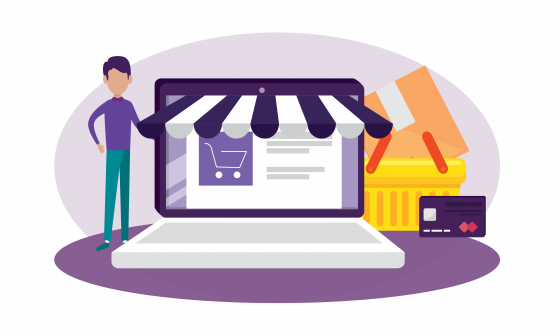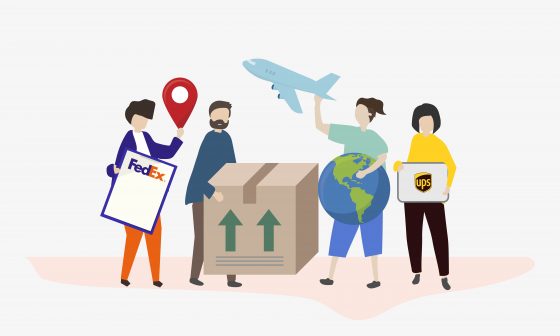2019 was a defining year for eCommerce. From autonomous short distance drone delivery tests to high sensitivity to socially conscious products, it was a year of rapid advancement for eCommerce. Walmart, Amazon, and Target have been paving the way in disrupting the eCommerce sector in unimaginable ways. Also, they have been instrumental in molding online buyer expectations.
To stay on top of their game, eTailers have to match the set expectation while keeping up with the trending innovations. Let us take a peek in the top 9 trends which are going to shape e-commerce in 2020:
1. Shorter order-delivery time
This year is going to be quite interesting as we will see e-commerce companies experimenting with faster delivery technology. On one hand shipping carriers such as FedEx, UPS, DHL have rolled out seven day and same-day delivery options. On the other drone delivery are ready to shed their experiment tag and take off to deliver their very first order.
Wikibuy lists out five key players who are certainly going to use drones for faster delivery.
These include names such as:
Amazon Alphabet UPS UberEats Swoop Aero
Over $350 million of VC drone funding was made in 2019 and it is being expected that 2.6 million operational commercial drones will be seen in the air by 2020. Talking of the profits, the technology is going to help shipping companies save approximately $50 million. Clearly, it is going to be revolutionary.
2. Green consumerism is red hot
Even since Greta Thunberg made her appearance in 2019 giving us a wake-up call, the environment, and climate change has become a topic of concern for many. All the major companies including Walmart, Target are closely monitoring their contribution to pollution. This is a clear indicator that green consumerism is going to be one of the topmost trends in e-commerce this year. Target rolled out an entire Go-Green product line: Ever Spring in 2019

According to GlobalWebIndex, 2018, 50% of digital consumers are going to make their purchasing decisions considering their environmental impact. People are waking up apropos the environmental and climatic situations and e-commerce is left with no option than to follow environment-friendly practices.
3. Voice commerce to pick up the pace:
“Alexa, is voice search on the rise”? Yes, says Alexa.
In 2018 and 2019, we saw an increase in the usage of Siri, Alexa and Ok Google which are nothing but just chatbots made for our better assistants. 2020 is going to chatbots for e-commerce as well. According to OC&C Strategy Consultants, 2018, 13% of U.S. smart speaker owners have been making purchases by voice since 2017 end and the number is predicted to go up to 55% by 2022. It is in its nascent stage at the moment but it is certain to be on the rise in the years to come.
4. Instagram and tik-tok define social commerce:
The buy button on Facebook and checkout option on Instagram are signs that social media is going to be a major tool of usage by e-commerce brands. Even since the introduction of social media, our lives have changed in the way we interact and connect with people and now, the time has come when it will change the way we shop. The influencers on Instagram and TikTok are no strangers, for the way they are used by the e-commerce brands for promoting their products and enabling better sales. This year the trend is going to get more pervasive.
5. Artificial Intelligence and Machine Learning come alive:
Artificial intelligence and machine learning can influence the choices of consumers significantly, helping both, the brand as well as consumers making the e-commerce a better experience for all. Not only will it help in assessing the choices of the consumers, but it will also help brands in many other segments such as pricing and discounting, demand forecasting, better personalization, and customer service. According to BusinessWire, 2018, Global retailer spending on Artificial Intelligence (AI) is going to move up from $2 billion in 2018 to $7.3 billion by 2022.
6. Mobile Commerce to go native with PWA:
Mobile is the new one-stop-shop place for everything today and the secret to e-commerce growth is to become mobile-friendly. Over the last couple of years, brands have been making their websites mobile user-friendly and this year, it is going to be widely adopted by the e-commerce players as well, more popularly to be called the technology of progressive web app (PWA). It is a mobile website with the look and feel of a native mobile app. It will ensure that your eCommerce site is being optimally used on all mobile devices.
7. Augmented Reality for integrated user experience:
Similar to artificial intelligence, Augmented reality has also been infiltrating various sectors. This year, it is expected to see a wider adoption of augmented reality in e-commerce as well. This will help customers visualize their products in a better way, avoiding the process of trials. Gartner says over 100 million customers will shop in Augmented Reality online by 2020.
8. Subscription eCommerce to build customer loyalty:
This is really intriguing as who would have thought eCommerce will get SAASy! This is a new trend which is riding higher very rapidly. Not only does it help customers to receive the products in a repeat mode, but it also explores new products based on sampling. This trend has been common amongst basic utility shopping such as food products, baby products, beer and wine, pet food, feminine hygiene products, and vitamins.
9. Mobile payments to become common:
Another crucial aspect of the digital world is a cashless economy. The online or mobile mode of payments is becoming common and 2020 is going to giving a further thrust to a cashless society. The impact will be seen on e-commerce as well. More and more mobile payments are going to be made for e-commerce purchases as well, in the time to come.
Some of the top mobile payment apps for eCommerce are
2020 is being seen as the culmination of all the advancements and changes in the last decade in e-commerce. Retailers need to step up their game to come out successful this year.


